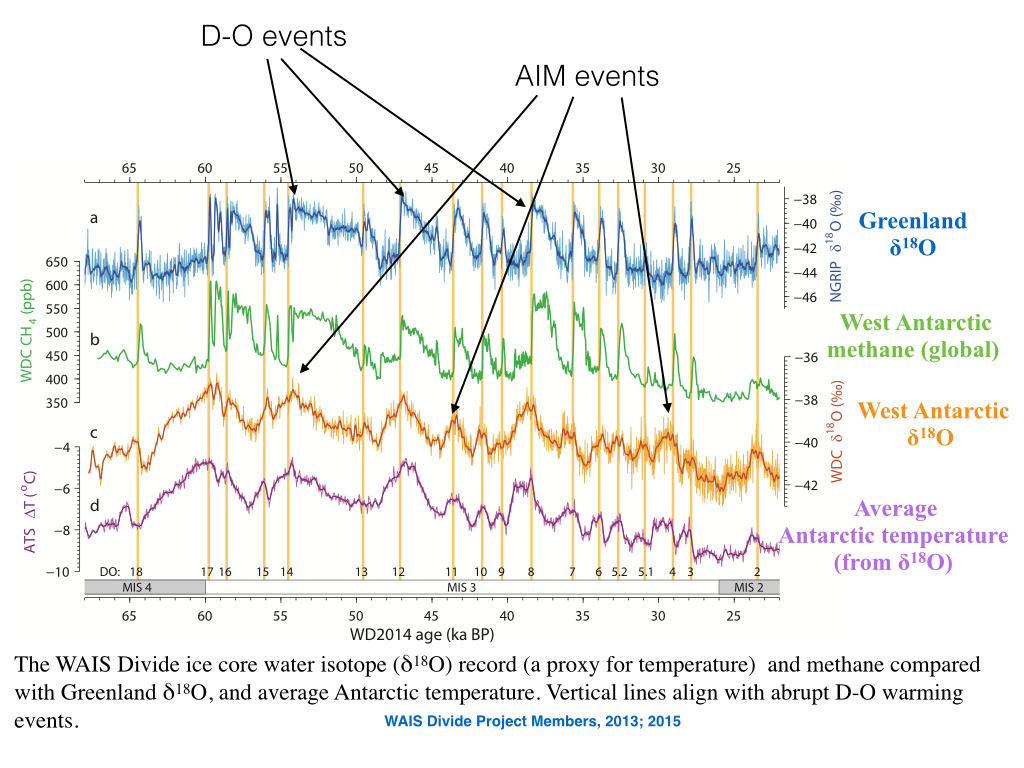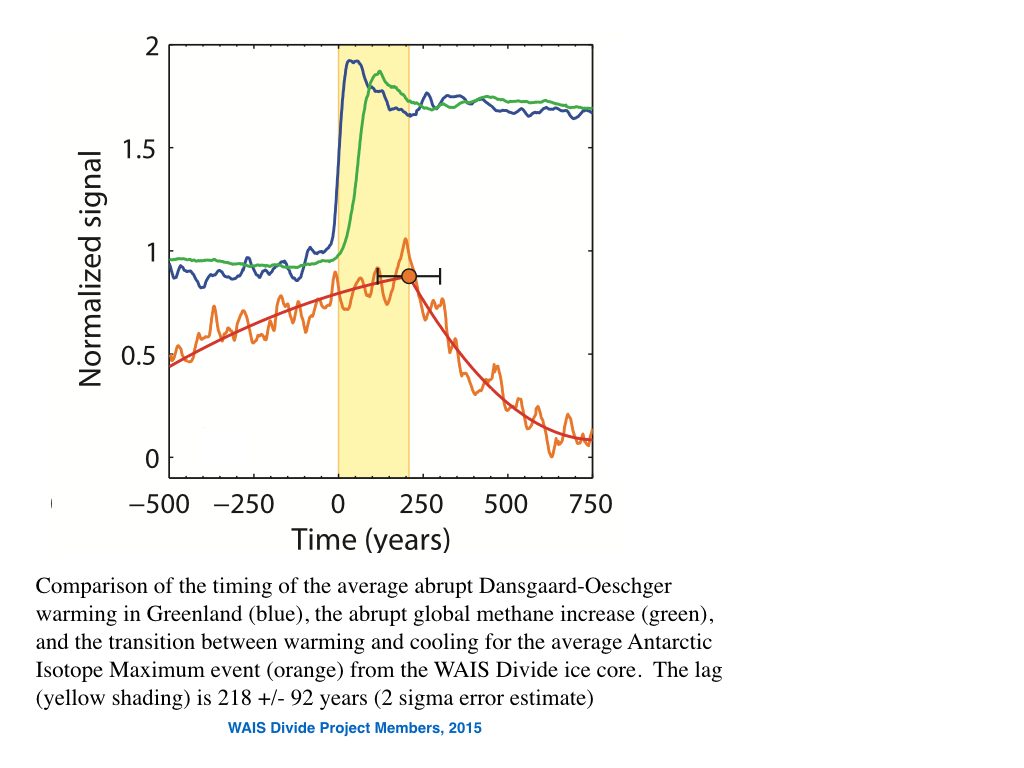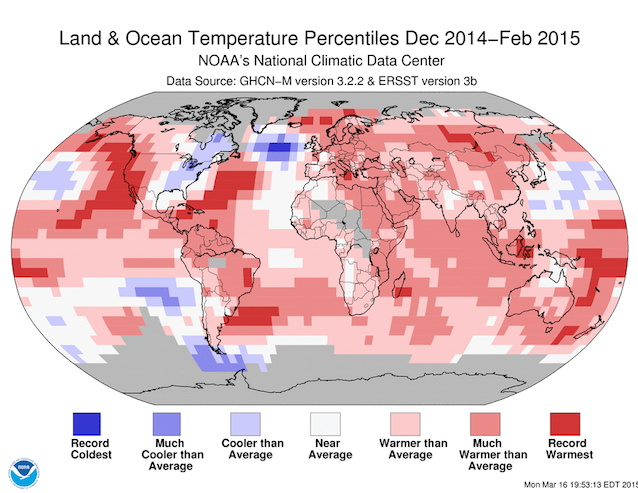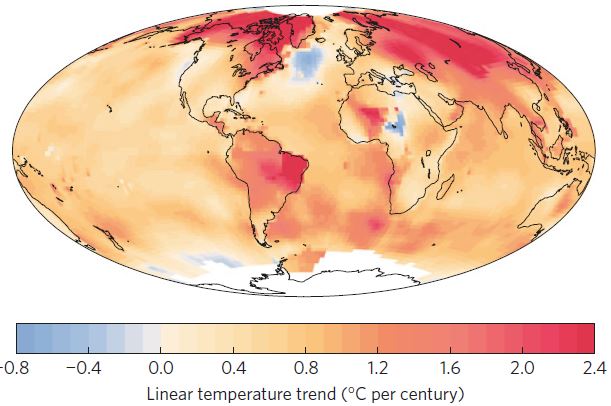This month’s open thread.
Climate Science
How long does it take Antarctica to notice the Northern Hemisphere is warming?
Eric Steig
A series of large and abrupt climate changes occurred during the last ice age, most clearly expressed in ice cores from Greenland and other paleoclimate data from the circum-North-Atlantic region. Since the discovery of these events, we’ve been trying to pin down the timing of abrupt climate changes elsewhere on the globe. Were there corresponding events in the Southern Hemisphere? And did they occur at the same time? A new paper published this week in Nature (April 30th, 2015) provide a significantly updated answer to these questions. Many in the climate research community — both modern climate and paleoclimate — will find the results quite interesting.
The new paper is the culmination of a huge effort to develop the best-dated long ice core record from Antarctica, rivaling the GISP2 and GRIP ice cores obtained from central Greenland in the early 1990s, and the more recent NGRIP and NEEM cores from North Greenland (e.g. NEEM Community Members, 2014). The core was obtained at the West Antarctic Ice Sheet divide (WAIS Divide), led by the Desert Research Institute and the University of Nevada, with the University of New Hampshire. The new paper was written by a consortium of postdocs, faculty, and students at the Oregon State University and University of Washington: Christo Buizert, myself, and Joel Pedro (now at University of Copenhagen), with Brad Markle, Ed Brook, Jeff Severinghaus and Ken Taylor. We have more than 70 other co-authors — faculty colleagues, students, postdocs, logistics coordinators, and ice-drillers — who all made substantial contributions as well. These deep ice cores are a lot of work!
We published records from the WAIS Divide ice core in 2013, covering the last two millennia and the last 30 thousand years (Steig et al., 2013, WAIS Divide Project Members, 2013). Our new work, WAIS Divide Project Members, 2015, extends the record to the bottom of the core (nearly the bottom of the ice sheet at 3400 m depth), and an age of 68 thousand years. Details on the timescale for the core are given in the open-access paper in Climate of the Past (Buizert et al., 2015). The new paper in Nature provides a comparison of the timing of changes in Antarctic temperature with the timing of the abrupt warming and cooling events that characterize the Greenland ice core records. Note that the comparison is actually made between the records of oxygen isotope ratios (δ18O), but we have very strong evidence that these track temperature quite faithfully on the relevant timescales, so I’ll use “temperature” here for simplicity.
The abrupt events in Greenland, characterized by rapid transitions from cold “stadial” to warm “interstadial” conditions and back, and commonly known as Dansgaard-Oeschger (D-O) events, were felt across the Northern Hemisphere almost immediately, as far as we can tell. But the impact of D-O events in Antarctica has been ambiguous. We’ve known for some time that temperatures in Antarctica change more slowly, and with much smaller amplitude, than in the Northern Hemisphere. In general, the Antarctic temperatures begin to decline when Greenland warms abruptly, and to increase when Greenland cools abruptly (Blunier et al., 1998). This relationship is often called the “bipolar seesaw” and is commonly attributed to the redistribution of heat between the Northern and Southern Hemispheres via changes in the Atlantic meridional overturning circulation (AMOC). We’ve also been pretty sure that each of the D-O interstadials has a corresponding warm peak in Antarctica, referred to as the “Antarctic Isotope Maximum” (AIM) events (EPICA Community Members, 2006, and Stefan Rahmstorf’s write-up in an earlier RealClimate post). But the exact phase relationship has been unknown, making it problematic to validate model simulations with confidence (see e.g. Roe and Steig, 2004, Steig, 2006).

The first paper to really start to pin down the phase relationship was that of Pedro et al., 2011, who showed that the most recent of the major abrupt events in Greenland cores (the Bølling warming about 14,700 years ago and the Younger Dryas cooling about 12,880 years ago), the direction of Antarctic temperatures changed at almost exactly the same time. (Note that the Antarctic temperatures don’t change abruptly — their slow trends simply reverse sign, as shown in the figure). But the uncertainties estimated by Pedro et al. were about 200 years on either side of zero. That’s impressively good precision for something that happened more than 10,000 years ago, but not quite good enough. Our new work firms up these numbers a lot, and shows that Antarctic temperatures did not really change at the same time as the abrupt events in Greenland. Instead, when an abrupt D-O warming occurs in Greenland, it takes about 200 years until the concomitant cooling begins in Antarctica. Similarly, when an abrupt cooling occurs in Greenland, it takes about 200 years until Antarctic starts warming up. Our uncertainties are much smaller, +/-95 years*, and it is very unlikely that our numbers overlap with zero. Antarctica, in other words, almost certainly takes a century or two to notice what is happening in the Greenland.

The 200-year timescale is fascinating, because it is longer than suggested by a number of modeling studies, such as the simple “bipolar seesaw” model of Stocker and Johnson, 2003, as well as the fully-coupled transient run of a general circulation model by He et al., 2013: both show an essentially instantaneous response between the Northern Hemisphere and the Antarctic. Yet it’s also shorter than implied by many discussions of the relationship; for example, we (Steig and Alley, 2002) made the case for a 400-year lag between Greenland Antarctica, which Schmittner et al., 2003 reproduced in a climate model in which the AMOC is perturbed.
So what does the intermediate timescale of ~200 years tell us? It’s important to recognize that there are reasons why one might expect either a “fast” propagation or a “slow” propagation of the Greenland climate signal to the Antarctic. The very large sea ice changes in the North Atlantic associated with D-O events would have an impact on the atmosphere, and this should propagate global signals almost instantaneously. Indeed, this must have occurred, or we wouldn’t have the evidence that we do for abrupt changes in places as far flung as China, India, or the tropical Pacific that are in phase with Greenland temperature change. Methane variations, which are probably of tropical origin, are in phase with Greenland temperature within about 20 years (e.g., Rosen et al., 2014).
The ocean itself can propagate signals very fast, via adjustment of the upper ocean by fast Kelvin waves propagating along the ocean boundaries (e.g. Johnson and Marshall, 2002). For example, Schmittner et al. (2003), and Rind et al. (2001) both found that the North Atlantic signal in their models propagates to the South Atlantic region very quickly, appearing in subsurface waters with a time lag of only about a few decades. However, they also find a century or multi-century delay in the further southward propagation from the South Atlantic to the Antarctic across the Antarctic Circumpolar Current (ACC). Furthermore, the propagation time varies with the strength of the ACC as imposed in the model.
There are, in short, multiple parts of the ocean and atmosphere system involved, and these have different timescales. It appears that our results are right about where the physics suggests they should be. A key factor in capturing this physics properly in models seems to be how (or how well) the ACC is simulated. That’s interesting, and highly relevant to modern climate studies. How the ACC is changing now, or may change in the future, is a topic of significant interest (Fyfe and Saeko, 2005; Böning et al., 2008). And the question of how long it will take the Antarctic to catch up with the rest of the globe is of critical importance to long term projections of the response of the ice sheet to climate change — and hence the response of sea level. The D-O events and the current anthropogenic global warming are of course very different beasts, but the long timescales indicated by our results are certainly in keeping with climate model projections of the future, showing that most of Antarctic should lag the rest of the planet (recent rapid warming on the Antarctic Peninsula and West Antarctica not withstanding).
Note that our results should not be taken as demonstrating anything very specific in terms of the cause of Dansgaard-O events. To be sure, the results demonstrate a clear north-to-south direction in the propagation of the climate signal associated with abrupt D-O warming and cooling events. But that doesn’t tell us what the driving “trigger” is. To use an analogy suggested by co-author Severinghaus, suppose we didn’t know anything about the physics relating lightning to thunder. Careful measurements of their relative timing would reveal that thunder always occurs very soon (or immediately) after lightning. But hearing thunder gives you only a general prediction of when the next lightning will be observed. One would correctly deduce that lightning causes thunder. That’s progress. But it would not tell you the cause of the lightning in the first place.
For my part, I’ve long been a skeptic about the old idea that the D-O variations are ultimately driven by meltwater and/or iceberg fluxes into the North Atlantic (the Day after Tomorrow scenario, if you will). There are only 6 clearly-identified Heinrich events (that is, layers of terrestrial sediment in ocean sediment cores from the North Atlantic, evidence for massive iceberg discharges from the Laurentide ice sheet) but there are at least 23 D-O events. It more likely that there is intrinsic variability in the coupled ocean-atmosphere system, as found for example in a long simulation with the climate model CCSM4 by Peltier and Vettoretti (2014 and 2015) (though there is debate about the validity of the very low values for ocean vertical mixing used in those simulations). Iceberg discharges are then just the consequence, not the cause, of changes in ocean circulation, as argued recently by Alvarez Solaz et al. (2013) and also suggested by Barker et al. (2015) who found that on average, evidence for icebergs in the North Atlantic follow, rather than precede, the abrupt coolings at the end of some D-O events. That doesn’t mean that the huge ice and meltwater fluxes associated with Heinrich events don’t have an impact; most modeling work suggests that they would. But it may be important in this context that our results show no dependence of the ~200-year lag on whether or not a Heinrich event has occurred: that is, there is no evidence that “Heinrich stadials” (the cold periods during which Heinrich events occur) are unusual with respect to ocean “seesaw” dynamics. The role of these events in millennial scale variability therefore remains an important, and open, research question (see e.g., Margari et al., 2010).
In the meantime our precise observations of the phasing of D-O and AIM events provide an important new constraint against which to validate model simulations designed to capture the dynamics of these interesting features of the climate system.
UPDATE: The News & Views article about our article, by Tas van Ommen is worth a read. Available here (subscription based only, I’m afraid).
Notes. *The ability to obtain such small uncertainties is owing to four main things. First, we have very high resolution measurements of methane in both the WAIS Divide and the Greenland cores; methane is globally well mixed, and so abrupt changes in methane must happen at the same time (within a year) in cores from both regions. This means that we can synchronize the age of the gas trapped in the bubbles within the cores very precisely. Second, we have very high resolution measurements of the nitrogen isotope ratio (15N/14N in atmospheric N2), also trapped in the bubbles in the cores. This isotope ratio provides information on the age difference between the gas and the ice, because gravitational settling increases the 15N/14N ratio; this depends on the thickness of the firn (the permeable ice between the surface and the impermeable ice at depth where bubbles are trapped). The deeper the firn, the longer it takes to trap gases, and the larger the age difference. It’s the age of the ice that we’re actually interested in, because this, not the gas trapped within the ice, is what the δ18O measurements are made on. Fourth, this age difference is much smaller at WAIS Divide than in any other long Antarctic record; it is at most ~500 years, compared with e.g., ~4000 years at Vostok. Finally, we also have unprecedentedly high resolution measurements of δ18O, and very high quality borehole temperature measurements, which together provide a very robust measure of the temperature variations through time.
Data: The data from the paper are all available in the Supplement to the paper. The timescale and the oxygen isotope data from our lab — what most people will be interested in — are available at the National Snow and Ice Data Center, at doi:10.7265/N5GT5K41.
References:
Barker, S., J. Chen, X. Gong, L. Jonkers, G. Knorr, D. Thornalley. Icebergs not the trigger for North Atlantic cold events. Nature 520, 333–336, 2015. http://dx.doi.org/10.1038/nature14330.
Blunier, T., J. Chappellaz, J. Schwander, A. Dällenbach, B. Stauffer, T.F. Stocker, D. Raynaud, J. Jouzel, H.B. Clausen, C.U. Hammer, and S.J. Johnsen, “”, Nature, vol. 394, pp. 739-743, 1998. http://dx.doi.org/10.1038/29447.
Böning, C.W., A. Dispert, M. Visbeck, S. R. Rintoul, F. U. Schwarzkop. The response of the Antarctic Circumpolar Current to recent climate change. Nature Geoscience 1, 864-869 (2008).
http://dx.doi.org/10.1038/ngeo362.
Buizert, C., Cuffey, K. M., Severinghaus, J. P., Baggenstos, D., Fudge, T. J., Steig, E. J., Markle, B. R., Winstrup, M., Rhodes, R. H., Brook, E. J., Sowers, T. A., Clow, G. D., Cheng, H., Edwards, R. L., Sigl, M., McConnell, J. R., and Taylor, K. C.: The WAIS Divide deep ice core WD2014 chronology – Part 1: Methane synchronization (68–31 ka BP) and the gas age–ice age difference, Clim. Past, 11, 153-173, 2015. http://dx.doi.org/10.5194/cp-11-153-2015.
EPICA Community Members, “One-to-one coupling of glacial climate variability in Greenland and Antarctica”, Nature, vol. 444, pp. 195-198, 2006. http://dx.doi.org/10.1038/nature05301
Fyfe, J.C. and O. A. Saenko, 2005: Human-Induced Change in the Antarctic Circumpolar Current. J. Climate, 18, 3068–3073. http://dx.doi.org/10.1175/JCLI3447.1
Grootes, P.M., M. Stuiver, J.W.C. White, S. Johnsen, and J. Jouzel, “Comparison of oxygen isotope records from the GISP2 and GRIP Greenland ice cores”, Nature, vol. 366, pp. 552-554, 1993. http://dx.doi.org/10.1038/366552a0.
He, F., J.D. Shakun, P.U. Clark, A.E. Carlson, Z. Liu, B.L. Otto-Bliesner, and J.E. Kutzbach, “Northern Hemisphere forcing of Southern Hemisphere climate during the last deglaciation”, Nature, vol. 494, pp. 81-85, 2013. http://dx.doi.org/10.1038/nature11822.
Margari, V., L.C. Skinner, P.C. Tzedakis, A. Ganopolski, M. Vautravers, N.J. Shackleton. The nature of millennial-scale climate variability during the past two glacial periods. Nature Geoscience 3, 127 – 131 (2010) http://dx.doi.org/10.1038/ngeo740.
NEEM Community Members, Eemian interglacial reconstructed from a Greenland folded ice core, Nature, vol. 493, pp. 489-494, 2013. http://dx.doi.org/10.1038/nature11789.
Pedro, J.B., T.D. van Ommen, S.O. Rasmussen, V.I. Morgan, J. Chappellaz, A.D. Moy, V. Masson-Delmotte, and M. Delmotte, The last deglaciation: timing the bipolar seesaw, Climate of the Past, vol. 7, pp. 671-683, 2011. http://dx.doi.org/10.5194/cp-7-671-2011.
Peltier, W. R., and G. Vettoretti, Dansgaard-Oeschger oscillations predicted in a comprehensive model of glacial climate: A “kicked” salt oscillator in the Atlantic, Geophys. Res. Lett.,41, 7306–7313, 2014. http://dx.doi.org/10.1002/2014GL061413.
Rind, D., G. Russell, G. Schmidt, S. Sheth, D. Collins, P. deMemocal, J. Teller. Effects of glacial meltwater in the GISS coupled atmosphere–ocean model, 2. A bipolar seesaw in Atlantic Deep Water production. Journal Geophysical Research, 106, pp. 27,355–27,365, 2001. http://dx.doi.org/10.1029/2001JD000954
Roe, G.H. and E.J. Steig. Characterization of Millennial-Scale Climate Variability. J. Climate, 17, 1929–1944. http://journals.ametsoc.org/doi/full/10.1175/1520-0442%282004%29017%3C1929%3ACOMCV%3E2.0.CO%3B2.
Rosen, J.L., E.J. Brook, J.P. Severinghaus, T. Blunier, L.E. Mitchell, J.E. Lee, J.S. Edwards, and V. Gkinis, An ice core record of near-synchronous global climate changes at the Bølling transition, Nature Geosci, vol. 7, pp. 459-463, 2014. http://dx.doi.org/10.1038/ngeo2147.
Schmittner, A., O. Saenko, and A. Weaver, Coupling of the hemispheres in observations and simulations of glacial climate change, Quaternary Science Reviews, vol. 22, pp. 659-671, 2003. http://dx.doi.org/10.1016/S0277-3791(02)00184-1.
Steig, E.J. et al., Q. Ding, J.W.C. White, M. Küttel, S.B. Rupper, T.A. Neumann, P.D. Neff, A.J.E. Gallant, P.A. Mayewski, K.C. Taylor, G. Hoffmann, D.A. Dixon, S.W. Schoenemann, B.R. Markle, T.J. Fudge, D.P. Schneider, A.J. Schauer, R.P. Teel, B.H. Vaughn, L. Burgener, J. Williams, and E. Korotkikh, “Recent climate and ice-sheet changes in West Antarctica compared with the past 2,000 years”, Nature Geosci, vol. 6, pp. 372-375, 2013. http://dx.doi.org/10.1038/NGEO1778.
Steig, E.J., Climate change: The south–north connection, Nature, vol. 444, pp. 152-153, 2006. http://dx.doi.org/10.1038/444152a
Stocker, T.F. and S.J. Johnsen, A minimum thermodynamic model for the bipolar seesaw, Paleoceanography, vol. 18, pp. n/a-n/a, 2003. http://dx.doi.org/10.1029/2003PA000920.
Vettoretti, G. and W.R. Peltier (2015), Interhemispheric air temperature phase relationships in the nonlinear Dansgaard-Oeschger oscillation. Geophys. Res. Lett., 42: 1180–1189. http://dx.doi.org/10.1002/2014GL062898.
WAIS Divide Project Members. Onset of deglacial warming in West Antarctica driven by local orbital forcing. Nature, 500: 440-444, 2013. http://dx.doi.org/10.1038/nature12376.
WAIS Divide Project Members. Precise interpolar phasing of abrupt climate change during the last ice age. Nature http://dx.doi.org/10.1038/nature14401.
Nenana Ice Classic 2015
Unsurprisingly to anyone looking at the exceptionally warm winter on the West Coast of North America, the Nenana Ice Classic had another near-record early breakup on Friday, netting some lucky winner(s) around $300,000 in prizes.
[Read more…] about Nenana Ice Classic 2015
The return of the iris effect?
Guest commentary from Andy Dessler (TAMU)
When a new scientific hypothesis is published, two questions always occur to me:
- Did the authors convincingly show the hypothesis was correct?
- If not, is the hypothesis actually correct?
The answers to these two questions may not be the same. A good example is Wegener’s theory of continental drift — his idea was fundamentally correct, but he lacked the data and physical mechanisms to convince the rest of scientific community. It would take several decades before enough data were gathered that the scientific community wholeheartedly endorsed plate tectonics.
 In 2001, Prof. Richard Lindzen and colleagues published his “iris hypothesis” (Lindzen et al., 2001). The hypothesis has two parts: First, in a warmer climate, enhanced precipitation efficiency will lead to less cloud being detrained into the troposphere from convection. Second, with less cloud cover, more infrared radiation can escape to space, thereby creating a strong climate-stabilizing negative cloud feedback that prevents significant warming from increasing greenhouse gases.
In 2001, Prof. Richard Lindzen and colleagues published his “iris hypothesis” (Lindzen et al., 2001). The hypothesis has two parts: First, in a warmer climate, enhanced precipitation efficiency will lead to less cloud being detrained into the troposphere from convection. Second, with less cloud cover, more infrared radiation can escape to space, thereby creating a strong climate-stabilizing negative cloud feedback that prevents significant warming from increasing greenhouse gases.
Within a few years, a number of analyses made clear that the evidence provided by Lindzen et al. had problems [e.g., Hartmann and Michelsen, 2002; Lin et al., 2002; Lin et al., 2004; Su et al., 2008]. Lindzen and colleagues responded to these critiques, but few were convinced by their arguments. By 2006, when I submitted an analysis of tropospheric water vapor that investigated whether there was an iris in that, one of the reviewers pointedly questioned why anyone was still working on this issue. I subsequently withdrew the paper.
Nevertheless, just because Lindzen et al. did not convincingly demonstrate their case does not mean the iris hypothesis is wrong. With that idea in mind, a new paper by Mauritsen and Stevens (2015) revisits the iris hypothesis. The most important part of their work was to simulate the iris in a climate model by artificially tweaking the model’s convective parameterization. They do this by increasing the rate of conversion of cloud water to rain as the climate warms, thereby reducing the amount of detraining condensate in a warmer climate. In effect, this imposes a tweak that mimics the iris effect – it is not a demonstration that the iris effect emerges from any physical mechanisms.
What they find is that, even though cloud cover is reduced as the climate warms, it does not generate a strong negative cloud feedback. While reducing cloud cover does indeed let more infrared energy out, it also lets more sunlight in. These two effects, while independently large, act in opposite directions. The net effect is the small residual of their difference. For runs with the strongest “iris”, the model’s climate sensitivity is reduced from 2.8°C for doubled carbon dioxide to 2.2°C — still well within the IPCC’s canonical range.
It’s also worth pointing out what this study doesn’t prove. It doesn’t validate Lindzen et al.’s original hypothesis — in fact, it does the opposite – even with an iris effect, the sensitivity does not become negligible. Additionally, there is little evidence that the rate of conversion of cloud water to rain actually changes with temperature, although Mauritsen and Stevens show that incorporating the iris into the model does improve the model’s simulations of some aspects of the climate system (even though it doesn’t change climate sensitivity much).
I view this as a what-if calculation of the impact of such a process. Future research may validate this, or it may not. This kind of calculation is one of the reasons why we like using models, of course.
Another argument against the iris comes from my work looking at the cloud feedback in response to short-term climate variability. If the iris provided a strong negative feedback, then we would expect to see it in response to short-term climate fluctuations. Analysis of observations doesn’t show anything like that (Dessler, 2013).
Overall, I think the debate over the iris hypothesis is a testament to the efforts the scientific community goes through to evaluate challenges to theories and find ways to improve our understanding of the climate (for instance, see Bill Ruddiman’s post from last week). This is one of the most important reasons I have such high confidence in the scientific process for figuring out how the universe works.
References
- R.S. Lindzen, M. Chou, and A.Y. Hou, "Does the Earth Have an Adaptive Infrared Iris?", Bulletin of the American Meteorological Society, vol. 82, pp. 417-432, 2001. http://dx.doi.org/10.1175/1520-0477(2001)082<0417:DTEHAA>2.3.CO;2
- D.L. Hartmann, and M.L. Michelsen, "No Evidence for Iris", Bulletin of the American Meteorological Society, vol. 83, pp. 249-254, 2002. http://dx.doi.org/10.1175/1520-0477(2002)083<0249:NEFI>2.3.CO;2
- B. Lin, B.A. Wielicki, L.H. Chambers, Y. Hu, and K. Xu, "The Iris Hypothesis: A Negative or Positive Cloud Feedback?", Journal of Climate, vol. 15, pp. 3-7, 2002. http://dx.doi.org/10.1175/1520-0442(2002)015<0003:TIHANO>2.0.CO;2
- B. Lin, T. Wong, B.A. Wielicki, and Y. Hu, "Examination of the Decadal Tropical MeanERBSNonscanner Radiation Data for the Iris Hypothesis", Journal of Climate, vol. 17, pp. 1239-1246, 2004. http://dx.doi.org/10.1175/1520-0442(2004)017<1239:EOTDTM>2.0.CO;2
- H. Su, J.H. Jiang, Y. Gu, J.D. Neelin, B.H. Kahn, D. Feldman, Y.L. Yung, J.W. Waters, N.J. Livesey, M.L. Santee, and W.G. Read, "Variations of tropical upper tropospheric clouds with sea surface temperature and implications for radiative effects", Journal of Geophysical Research: Atmospheres, vol. 113, 2008. http://dx.doi.org/10.1029/2007JD009624
- T. Mauritsen, and B. Stevens, "Missing iris effect as a possible cause of muted hydrological change and high climate sensitivity in models", Nature Geoscience, vol. 8, pp. 346-351, 2015. http://dx.doi.org/10.1038/ngeo2414
- A.E. Dessler, "Observations of Climate Feedbacks over 2000–10 and Comparisons to Climate Models*", Journal of Climate, vol. 26, pp. 333-342, 2013. http://dx.doi.org/10.1175/jcli-d-11-00640.1
An Online University Course on the Science of Climate Science Denial
Guest post from John Cook, University of Queensland
For many years, RealClimate has been educating the public about climate science. The value of climate scientists patiently explaining the science and rebutting misinformation directly with the public cannot be overestimated. When I began investigating this issue, my initial searches led me here, which was invaluable in increasing my understanding of our climate and making sense of misinformation. RealClimate has inspired and empowered a host of climate communicators such as myself to step forward and help make climate science more accessible to the general public.
To further the work of educating the public, and empowering people to communicate the realities of climate change, the Skeptical Science team has collaborated with The University of Queensland to develop a MOOC, Making Sense of Climate Science Denial. MOOC stands for Massive (we’ve already had thousands of students sign up from over 130 countries) Open (available for free to everyone) Online (web-based, no software required) Course.
The course examines the science of climate science denial. Why do a small but vocal minority reject the scientific evidence for climate change? What techniques do they use to cast doubt on the science? And we examine the all-important question – based on scientific research, how should we respond to science denial?
Several strands of research in cognitive psychology, educational research and a branch of psychology called “inoculation theory” all point the way to neutralising the influence of science denial. The approach is two-fold: communicate the science but also explain how that science can be distorted.
So our course looks at the most common climate myths you’re likely to encounter online or in the media. We examine myths casting doubt on the reality of global warming. We explore the many human fingerprints on climate change. We look at the messages from past climate change and what climate models tell us about the future. And we look at how climate change is impacting every part of society and the environment. As we examine myths touching on all these parts of climate science, we shine the spotlight on the fallacies and techniques used to distort the science.
As well as our short video lectures debunking climate myths, we also interviewed many of the world’s leading scientists. I had the privilege to speak to Ben Santer, Katharine Hayhoe, Richard Alley, Phil Jones, Naomi Oreskes and let’s not forget my long, fascinating conversation with Michael Mann. I was also lucky enough to interview Sir David Attenborough at the Great Barrier Reef. We spoke to both climate scientists and social scientists who study the psychology of climate science denial. Some of the most powerful moments from those interviews came when the scientists described the attacks they’d personally experienced because of their climate research:
Our MOOC starts next Tuesday, April 28. It’s a free online course hosted by the not-for-profit edX (founded by Harvard University & MIT). It runs for 7 weeks, requiring 1 to 2 hours per week. You can enroll at http://edx.org/understanding-climate-denial.
A Scientific Debate
Guest posting from Bill Ruddiman, University of Virginia
Recently I’ve read claims that some scientists are opposed to AGW but won’t speak out because they fear censure from a nearly monolithic community intent on imposing a mainstream view. Yet my last 10 years of personal experience refute this claim. This story began late in 2003 when I introduced a new idea (the ‘early anthropogenic hypothesis’) that went completely against a prevailing climatic paradigm of the time. I claimed that detectable human influences on Earth’s surface and its climate began thousands of years ago because of agriculture. Here I describe how this radically different idea was received by the mainstream scientific community.
Was my initial attempt to present this new idea suppressed? No. I submitted a paper to Climatic Change, then edited by Steve Schneider, a well-known climate scientist and AGW spokesman. From what I could tell, Steve was agnostic about my idea but published it because he found it an interesting challenge to the conventional wisdom. I also gave the Emiliani lecture at the 2003 December American Geophysical Union (AGU) conference to some 800 people. I feel certain that very few of those scientists came to my talk believing what my abstract claimed. They attended because they were interested in a really new idea from someone with a decent career reputation. The talk was covered by many prominent media sources, including the New York Times and The Economist. This experience told me that provocative new ideas draw interest because they are provocative and new, provided that they pass the key ‘sniff test’ by presenting evidence in support of their claims.
Did this radical new idea have difficulty receiving research funding? No. Proposals submitted to the highly competitive National Science Foundation (NSF) with John Kutzbach and Steve Vavrus have been fully funded since 2004 by 3-year grants. Even though the hypothesis of early anthropogenic effects on climate has been controversial (and still is for some), we crafted proposals that were carefully written, tightly reasoned, and focused on testing the new idea. As a result, we succeeded against negative funding odds of 4-1 or 5-1. One program manager told me he planned to put our grant on a short list of ‘transformational’ proposals/grants that NSF had requested. That didn’t mean he accepted our hypothesis. It meant that he felt that our hypothesis had the potential to transform that particular field of paleoclimatic research, if proven correct.
Were we able to get papers published? Yes. As any scientist will tell you, this process is rarely easy. Even reviewers who basically support what you have to say will rarely hand out ‘easy-pass’ reviews. They add their own perspective, and they often point out useful improvements. A few reviews of the 30-some papers we have published during the last 11 years have come back with extremely negative reviews, seemingly from scientists who seem deeply opposed to anything that even hints at large early anthropogenic effects. While these uber-critical reviews are discouraging, I have learned to put them aside for a few days, give my spirits time to rebound, and then address the criticisms that are fair (that is, evidence-based), explain to the journal editor why other criticisms are unfair, and submit a revised (and inevitably improved) paper. Eventually, our views have always gotten published, although sometimes only after considerable effort.
The decade-long argument over large early anthropogenic effects continues, although recent syntheses of archeological and paleoecological data have been increasingly supportive. In any case, I continue to trust the scientific process to sort this debate out. I suggest that my experience is a good index of the way the system actually operates when new and controversial ideas emerge. I see no evidence that the system is muffling good new ideas.
Unforced Variations: April 2015
Reflections on Ringberg
As previewed last weekend, I spent most of last week at a workshop on Climate Sensitivity hosted by the Max Planck Institute at Schloss Ringberg. It was undoubtedly one of the better workshops I’ve attended – it was focussed, deep and with much new information to digest (some feel for the discussion can be seen from the #ringberg15 tweets). I’ll give a brief overview of my impressions below.
A hypothesis about the cold winter in eastern North America + Update
The past winter was globally the warmest on record. At the same time it set a new cold record in the subpolar North Atlantic – and it was very cold in the eastern parts of North America. Are these things related?
Two weeks ago NOAA published the following map of temperature anomalies for the past December-January-February (i.e. the Northern Hemisphere winter). One week ago, we published a paper in Nature Climate Change (which had been in the works for a few years) arguing that the cold in the subpolar North Atlantic is indicative of an AMOC slowdown (as discussed in my last post). Immediately our readers started to ask (as we indeed had been asking ourselves): does the cold winter in eastern North America (culminating in the Inhofe snowball incident) have anything to do with what is going on in the Atlantic?
 Fig. 1 Temperature anomaly map for the past december-january-february, from NOAA.
Fig. 1 Temperature anomaly map for the past december-january-february, from NOAA.
[Read more…] about A hypothesis about the cold winter in eastern North America + Update
References
- S. Rahmstorf, J.E. Box, G. Feulner, M.E. Mann, A. Robinson, S. Rutherford, and E.J. Schaffernicht, "Exceptional twentieth-century slowdown in Atlantic Ocean overturning circulation", Nature Climate Change, vol. 5, pp. 475-480, 2015. http://dx.doi.org/10.1038/nclimate2554
What’s going on in the North Atlantic?
The North Atlantic between Newfoundland and Ireland is practically the only region of the world that has defied global warming and even cooled. Last winter there even was the coldest on record – while globally it was the hottest on record. Our recent study (Rahmstorf et al. 2015) attributes this to a weakening of the Gulf Stream System, which is apparently unique in the last thousand years.
The whole world is warming. The whole world? No! A region in the subpolar Atlantic has cooled over the past century – unique in the world for an area with reasonable data coverage (Fig. 1). So what’s so special about this region between Newfoundland and Ireland?
Fig. 1 Linear temperature trend from 1900 to 2013. The cooling in the subpolar North Atlantic is remarkable and well documented by numerous measurements – unlike the cold spot in central Africa, which on closer inspection apparently is an artifact of incomplete and inhomogeneous weather station data.

